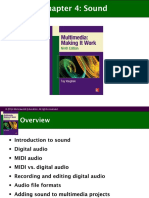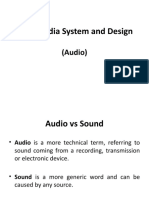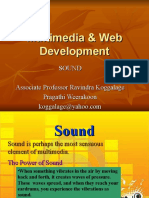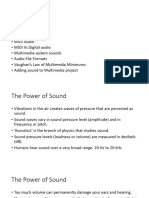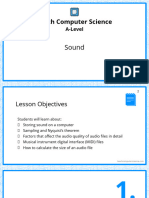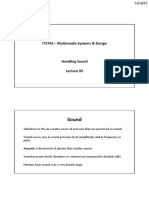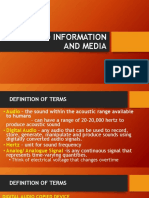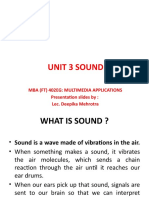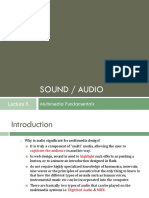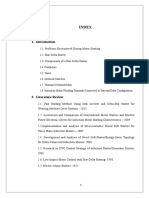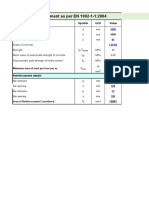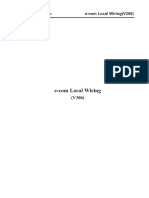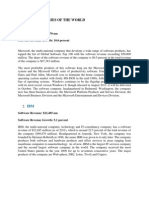10/3/11
Chapter 4: Sound
© 2011 The McGraw-Hill Companies, Inc. All rights reserved
Overview
• Introduction to sound
• Digital audio
• MIDI audio
• MIDI versus digital audio
• Recording and editing digital audio
• Audio file formats
• Adding sound to multimedia projects
© 2011 The McGraw-Hill Companies, Inc. All rights reserved
Introduction to Sound
• Vibrations in the air create waves of
pressure that are perceived as sound.
• Sound waves vary in sound pressure level
(amplitude) and in frequency or pitch.
© 2011 The McGraw-Hill Companies, Inc. All rights reserved
1
� 10/3/11
Introduction to Sound cont.
• “Acoustics” - the branch of physics that
studies sound.
• Sound pressure levels (loudness or volume)
are measured in decibels (dB).
• Sounds are produced by the conversion of
energy into vibrations in the air or some
other elastic medium
• Sound -> vibrates eardrum -> inner ear
-> nerve impulses -> brain interprets
© 2011 The McGraw-Hill Companies, Inc. All rights reserved
Introduction to Sound cont.
• “Frequency Spectrum” - a sound’s
description in terms of the relative
amplitudes of its frequency components.
© 2011 The McGraw-Hill Companies, Inc. All rights reserved
Introduction to Sound cont.
• Human ear ~ 20 Hz - 20 kHz.
• Higher frequencies lost as we age.
• A single note has a distinctive attack, and
subsequently will decay.
• Frequency spectrum grows then dies away.
© 2011 The McGraw-Hill Companies, Inc. All rights reserved
2
� 10/3/11
Introduction to Sound cont.
• Waveform - graphical plot of amplitude
against time.
• Dynamic range - difference between the
loudest and quietest sounds.
• Boogie Woogie ex
© 2011 The McGraw-Hill Companies, Inc. All rights reserved
Digital Audio
• Digital audio data is the actual
representation of sound, stored in the form
of samples.
• Samples represent the amplitude (or
loudness) of sound at a discrete point in
time.
• The quality of digital recording depends on
the sampling rate (or frequency), that is, the
number of samples taken per second.
© 2011 The McGraw-Hill Companies, Inc. All rights reserved
Digital Audio (continued)
• The three sampling frequencies most often
used in multimedia are CD-quality 44.1 kHz
16bit (65,536), 22.05 kHz, and 11.025 kHz.
• The number of bits used to describe the
amplitude of a sound wave when sampled
determines the sample size.
© 2011 The McGraw-Hill Companies, Inc. All rights reserved
3
� 10/3/11
Digital Audio (continued)
• Digital audio is device independent.
• The value of each sample is rounded off to
the nearest integer (quantization).
© 2011 The McGraw-Hill Companies, Inc. All rights reserved
Digital Audio (continued)
• Crucial aspects of preparing
digital audio files are:
– Balancing the need for sound
quality against available RAM
and hard disk resources
– Setting appropriate recording
levels to get a high-quality
and clean recording
– Avoid Clipping!!!
© 2011 The McGraw-Hill Companies, Inc. All rights reserved
Digital Audio (continued)
• Once a recording has been completed,
it almost always needs to be edited.
• Basic sound editing operations include
trimming, splicing and assembly, volume
adjustments, and working on multiple tracks.
© 2011 The McGraw-Hill Companies, Inc. All rights reserved
4
� 10/3/11
Digital Audio (continued)
• Additional available operations: format
conversion, resampling or downsampling,
fade-ins, fade-outs, equalization,
time stretching, digital signal processing,
looping, and reversing sounds.
• Short loops may be used to create voices for
samplers; longer loops may be combined to
build songs from repeating sections.
© 2011 The McGraw-Hill Companies, Inc. All rights reserved
Digital Audio (continued)
• Audio resolution determines the accuracy
with which sound can be digitized.
• Size of a monophonic digital recording =
sampling rate x (bit resolution/8) x 1.
• Size of stereo recording = sampling rate x
duration of recording in seconds x (bit
resolution/8) x 2.
© 2011 The McGraw-Hill Companies, Inc. All rights reserved
MIDI Audio
• Since they are small, MIDI (Musical
Instruments Digital Interface) files
embedded in web pages load and play
promptly.
• The length of a MIDI file can be changed
without affecting the pitch of the music or
degrading audio quality.
• Working with MIDI requires knowledge of
music theory.
© 2011 The McGraw-Hill Companies, Inc. All rights reserved
5
� 10/3/11
MIDI Audio (continued)
© 2011 The McGraw-Hill Companies, Inc. All rights reserved
MIDI Audio (continued)
• MIDI is a shorthand representation of music
stored in numeric form.
• It is not digitized sound.
• A sequencer software and sound synthesizer
is required in order to create MIDI scores.
• MIDI is device dependent.
© 2011 The McGraw-Hill Companies, Inc. All rights reserved
MIDI Audio (continued)
© 2011 The McGraw-Hill Companies, Inc. All rights reserved
6
� 10/3/11
MIDI Versus Digital Audio
• MIDI is device dependent, digitized
audio is device independent.
• MIDI files are typically much smaller than
digitized audio.
• MIDI files may sound better than digital
audio files when played on a high-quality
MIDI device.
© 2011 The McGraw-Hill Companies, Inc. All rights reserved
MIDI Versus Digital Audio
(continued)
• With MIDI, it is difficult to play back spoken
dialog, while digitized audio can do so with
ease.
• MIDI does not have consistent playback
quality, digital audio does.
• Need knowledge of music theory in order to
run MIDI, while digital audio does not have
this requirement.
© 2011 The McGraw-Hill Companies, Inc. All rights reserved
Recording and Editing Digital Audio
• Multimedia sound is either digitally recorded
audio or MIDI (Musical Instrumental Digital
Interface) music.
© 2011 The McGraw-Hill Companies, Inc. All rights reserved
7
� 10/3/11
Audio File Formats
• A sound file’s format is a recognized
methodology for organizing data bits of
digitized sound into a data file.
• On the Macintosh, digitized sounds may be
stored as data files, resources, or
applications such as AIFF or AIFC.
• In Windows, digitized sounds are usually
stored as WAV files.
© 2011 The McGraw-Hill Companies, Inc. All rights reserved
Audio File Formats (continued)
• MP3 compression is a space saver.
• MP4 is used when audio and video are
streamed together.
• ACC (Advanced Audio Coding) is used by
Apple’s iTunes store.
© 2011 The McGraw-Hill Companies, Inc. All rights reserved
Adding Sound to Multimedia Project
• File formats compatible with multimedia
authoring software being used, along with
delivery mediums, must be determined.
• Sound playback capabilities offered by end
users’ systems must be studied.
• The type of sound, whether background
music, special sound effects, or spoken
dialog, must be decided.
• Digital audio or MIDI data should be
selected on the basis of the location and
time of use.
© 2011 The McGraw-Hill Companies, Inc. All rights reserved
8
� 10/3/11
Adding Sound to Multimedia Project
(continued)
• Create or purchase source material.
• Edit the sounds to fit your project.
• Test the sounds to be sure they are timed
properly with your project.
© 2011 The McGraw-Hill Companies, Inc. All rights reserved
Adding Sound to Multimedia Project
(continued)
• Professional sound
– Compression techniques reduce space, but
reliability suffers.
– Space can be conserved by downsampling or
reducing the number of sample slices taken per
second.
– File size of digital recording (in bytes) =
sampling rate x duration of recording (in secs) x
(bit resolution/8) x number of tracks.
© 2011 The McGraw-Hill Companies, Inc. All rights reserved
Adding Sound to Multimedia Project
(continued)
• Recording on inexpensive media rather than
directly to disk prevents the hard disk from
being overloaded with unnecessary data.
• The project’s equipment and standards must
be in accordance with the requirements.
• It is vital to maintain a high-quality
database that stores the original sound
material.
© 2011 The McGraw-Hill Companies, Inc. All rights reserved
9
� 10/3/11
Adding Sound to Multimedia Project
(continued)
• Keeping track of your sounds
– Audio CDs
• The Red Book (ISO 10149) standard for digitally
encoding high-quality stereo.
• 16 bit sample size and 44.1 KHz sampling rate.
• The amount of digital sound information required
for high-quality sound takes up a great deal of disk
storage space.
– Sound for your mobile
– Sound for the Internet
© 2011 The McGraw-Hill Companies, Inc. All rights reserved
Adding Sound to Multimedia Project
(continued)
Web browsers must be told what to do when they
download file types.
© 2011 The McGraw-Hill Companies, Inc. All rights reserved
Adding Sound to Multimedia Project
(continued)
• Sound and image synchronization must be
tested at regular intervals.
• The speed at which most animations and
computer-based videos play depends on the
user’s CPU.
© 2011 The McGraw-Hill Companies, Inc. All rights reserved
10
� 10/3/11
Adding Sound to Multimedia Project
(continued)
• The sound’s RAM requirements as well as
the user’s playback setup must be
evaluated.
• Copyrighted material should not be recorded
or used without securing appropriate rights
from the owner or publisher.
© 2011 The McGraw-Hill Companies, Inc. All rights reserved
Summary
• Vibrations in the air create waves of
pressure that are perceived as sound.
• Multimedia system sound is digitally
recorded audio or MIDI (Musical
Instrumental Digital Interface) music.
• Digital audio data is the actual
representation of a sound, stored in the
form of samples.
© 2011 The McGraw-Hill Companies, Inc. All rights reserved
Summary (continued)
• MIDI is a shorthand representation of music
stored in numeric form.
• Digital audio provides consistent playback
quality.
• MIDI files are much smaller than digitized
audio.
• MIDI files sound better than digital audio
files when played on a high-quality MIDI
device.
© 2011 The McGraw-Hill Companies, Inc. All rights reserved
11


